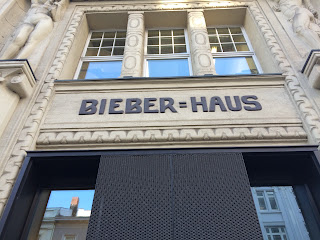I'll start by addressing the elephant in the room. No, people from Hamburg are NOT called Hamburgers. To say I went to Hamburg solely to find this out would not be entirely truthful, nor would it be entirely false. So there we are.
I ended up in Hamburg because Lindsay, a good friend of mine, is a bit of a Germanophile. The other name for this is a Teutonophile but that makes her sound a little pervy so I opted for the first. Lindsay has spent the better part of a year taking German evening classes at King's College London's well-appointed Language College. She was keen to put these skills to good use and after a drawn-out flight search, we dumped our unknowingly expensive notions of a trip to Morocco and opted for Germany's second city.
I timed the trip impeccably with my forays into the world of veganism and was delighted to find that German food has moved on from my previous trip to Munich. I suppose I shouldn't be surprised; Germany seems to be one of Europe's most progressive countries, embracing trends with both hands. From traditional spatzle (with sauerkraut and smoked tofu, below) to more trendy quinoa burritos, I ate well. And there was the traditional gigantic pretzel with your stein of beer which obviously did not disappoint.
The city itself is, unsurprisingly, a working city. With the country's biggest port and 1.8 million people bustling around, we got a good feeling for what it might be like to live there.
February weather was cold and crisp but we got a few sunny moments. In those snippets of time, it was easy to imagine how Hamburg's residents might embrace the parks, open space and pavement cafes. Despite the cold, people did spend their time outside, and so the city did feel very much alive (even though the pictures don't really capture this).
In later wanderings, we made our way to the Saint Pauli neighbourhood, known for its sex shops and sex-trade as well as the Beatles, who played near the Reeperbahn area. As often happens, little hipster neighbourhoods have sprung up next to this part of town and so we wandered in and out of boutiques, museums and bookshops in the Schanzenviertel area too.
Here, the vibe was distinct--a mix of young skateboarders, students, vegetarian hipsters and the like. It felt a lot more alive than other parts of the city which is probably why we spent so much time getting lost amongst the various side streets.
Back in the city centre, ancient architecture, all connected to various trades, continued to intermingle with new commerce and buildings.
And whilst five whole days in this city in motion might have been a bit too much, it was good to see the inner workings of a confident Hamburg. We felt like old pros by the end of our trip, working the metro and trains with ease, and taking in pints of proper German beer in proper German beer houses. For a February half term bit of escapism, that worked perfectly.





































